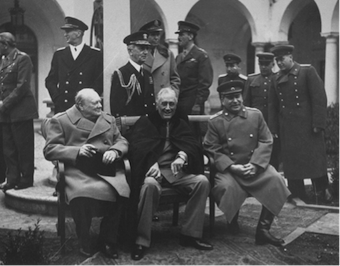

|
From World War to Cold War  Churchill, Roosevelt and Stalin at the Yalta Conference As the Red Army advanced into Eastern Europe during 1944-45, Stalin was already thinking about the post-war situation and about imposing Soviet-style regimes on the liberated territories. He thought of Poland and the Baltic lands as a buffer zone to protect the USSR against a possible German revival - a concept born of Soviet fears of a foreign invasion rooted in the trauma of 22 June 1941. Stalin spoke of 'spheres of influence' in his talks with the Allies about the division of the occupation zones. But where the British and Americans took these spheres of influence to mean protectorates, without interference in domestic politics by the occupation force, Stalin saw them as a license for the Sovietization of the occupied societies. By the end of 1944 he was counting on a sphere of influence that would include Finland, Sweden, Poland, Hungary, Czechoslovakia, Romania, Yugoslavia and Turkey. Resentful of the Allies' delays in opening a second front in Europe, he justified this claim as compensation for having done the lion's share of the fighting. The Allies appeased Stalin in the early months of 1945. The Red Army was racing to Berlin, and they needed Soviet help against Japan. At the Yalta Conference in February they more or less agreed to Stalin's plans for a Polish government friendly to the Russians, insisting only on a vague undertaking by the Soviets to reorganize the Communist-dominated Lublin government 'on a broader democratic basis' including Poles returning from abroad. |
© 2014 Orlando Figes | All Rights Reserved